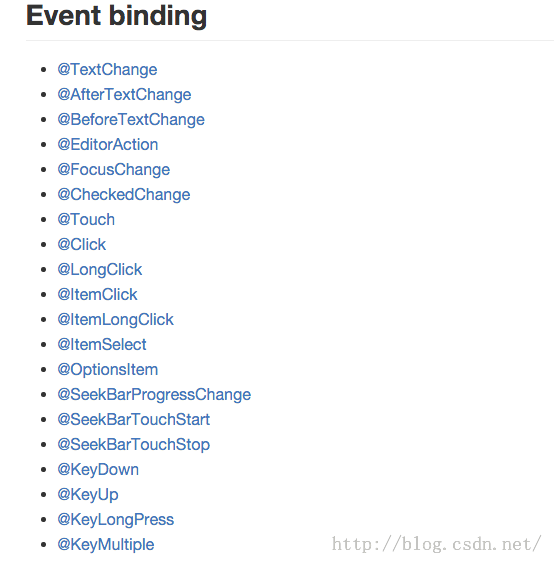(一).前言:
前面我们已经对于AndroidAnnotations框架的Injection标签做了讲解,今天我们开始具体学习一下事件绑定方法(Event Binding)。
FastDev4Android框架项目地址:https://github.com/jiangqqlmj/FastDev4Android
已更新如下:

(二).@TextChange
该注解用户定义当TextView或者TextView的子类中的文本发生改变回调事件方法anroid.text.TextWatcher.onTextChanget(CharSequence s,int start,intbefore,int count)来进行处理。该注解的参数值为一个或者多个TextView或者该子类的R.id.引用。如果没有设置,那么方法名字将会作为R.id.属性名称。该方法中可以有多个参数。
- android.widget.TextView注解知道那个view接收到了事件
- Java.lang.CharSequence可以获取到发生改变的文本
- Intstart表示改变文本的起始位置
- Intbefore表示文本修改之前的长度
- Intcount表示文本修改的数量
下面就是使用实例:
@TextChange(R.id.helloTextView)
void onTextChangesOnHelloTextView(CharSequencetext, TextView hello, int before, int start, int count) {
// Something Here
}
@TextChange
void helloTextViewTextChanged(TextView hello){
// Something Here
}
@TextChange({R.id.editText,R.id.helloTextView})
void onTextChangesOnSomeTextViews(TextView tv,CharSequence text) {
// Something Here
}
@TextChange(R.id.helloTextView)
void onTextChangesOnHelloTextView() {
// Something Here
}
(三).@BeforeTextChange
该用来注解回调TextView或者TextView子类文本发生变化之前的方法android.text.TextWathcher.beforeTextChanged(CharSequences,int start, int count,int after).
使用实例如下:
@BeforeTextChange(R.id.helloTextView)
void beforeTextChangedOnHelloTextView(TextViewhello, CharSequence text, int start, int count, int after) {
// Something Here
}
@BeforeTextChange
void helloTextViewBeforeTextChanged(TextViewhello) {
// Something Here
}
@BeforeTextChange({R.id.editText,R.id.helloTextView})
void beforeTextChangedOnSomeTextViews(TextViewtv, CharSequence text) {
// Something Here
}
@BeforeTextChange(R.id.helloTextView)
void beforeTextChangedOnHelloTextView() {
// Something Here
}
(四).@AfterTextChange
该用来注解回调TextView或者TextView子类文本发生变化之后的方法android.text.TextWathcher.afterTextChanged(Editable s)
使用实例如下:
@AfterTextChange(R.id.helloTextView)
void afterTextChangedOnHelloTextView(Editabletext, TextView hello) {
// Something Here
}
@AfterTextChange
void helloTextViewAfterTextChanged(TextViewhello) {
// Something Here
}
@AfterTextChange({R.id.editText,R.id.helloTextView})
void afterTextChangedOnSomeTextViews(TextViewtv, Editable text) {
// Something Here
}
@AfterTextChange(R.id.helloTextView)
void afterTextChangedOnHelloTextView() {
// Something Here
}
(五).@EditorAction
自AndroidAnnotations3.1起
该注解用来处理android.widget.TextView.OnEditorActionListener#onEditorAction(android.widget.TextView,int,android.View.KeyEvent)回调的事件.当接收处理编辑事件时候。
该注解的参数值为一个或者多个TextView或者该子类的R.id.引用。如果没有设置,那么方法名字将会作为R.id.属性名称。该方法中可以有多个参数。
- Android.widget.TextView参数表示该接收到事件的view
- Int参数表示事件动作的action
- android.view.KeyEvent表示具体的事件
该方法返回的类型为void或者boolean。boolean返回true或者false表示当前事件是否被消费掉。如果返回void那么总会返回true给监听器,表示事件已经被消费掉了。
实例如下:
@EditorAction(R.id.helloTextView)
void onEditorActionsOnHelloTextView(TextViewhello, int actionId, KeyEvent keyEvent) {
// Something Here
}
@EditorAction
void helloTextViewEditorAction(TextViewhello) {
// Something Here
}
@EditorAction({R.id.editText,R.id.helloTextView})
void onEditorActionsOnSomeTextViews(TextViewtv, int actionId) {
// Something Here
}
@EditorAction(R.id.helloTextView)
void onEditorActionsOnHelloTextView() {
// Something Here
}
@EditorAction(R.id.helloTextView)
boolean onEditorActionsOnHelloTextView() {
// Something Here
return false;
}
(六).@FocusChange
该注解用来定义方法当view的焦点状态发生的改变的时候回调android.view.View.OnFoucChangeListener(View view,boolean hasFocus)的方法来处理事件。
- android.viw.View参数表示接受事件的view
- hasFocus boolean表示获取或者失去焦点
下面是使用@FocusChange注解的实例:
@FocusChange(R.id.helloTextView)
voidfocusChangedOnHelloTextView(View hello, boolean hasFocus) {
// Something Here
}
@FocusChange
voidhelloTextViewFocusChanged(View hello) {
// Something Here
}
@FocusChange({R.id.editText,R.id.helloTextView})
voidfocusChangedOnSomeTextViews(View hello, boolean hasFocus) {
// Something Here
}
@FocusChange(R.id.helloTextView)
voidfocusChangedOnHelloTextView() {
// Something Here
}
(七).@CheckedChange
该注解用来定义处理当compound button状态发生改变的时候回调android.widget.CompoundButton.OnCheckedChangeListener.onCheckedChanged(CompoundButtonbuttonView,boolean isChecked)方法来处理事件;
- android.widget.CompoundButton该参数表示接受事件的compound button
- isChecked参数表示view是否被选中
下面为@CheckedChange注解的使用实例
@CheckedChange(R.id.helloCheckBox)
voidcheckedChangeOnHelloCheckBox(CompoundButton hello, boolean isChecked) {
// Something Here
}
@CheckedChange
voidhelloCheckBoxCheckedChanged(CompoundButton hello) {
// Something Here
}
@CheckedChange({R.id.aCheckBox,R.id.helloCheckBox})
voidcheckedChangedOnSomeCheckBoxs(CompoundButton hello, boolean isChecked) {
// Something Here
}
@CheckedChange(R.id.helloCheckBox)
voidcheckedChangedOnHelloCheckBox() {
// Something Here
}
(八).@Click
该@Click注解的方法当相关的view被进行点击的时候会进行回调进行处理。被点击的view的id可以设置成注解的参数;例如:@Click(R.id.myButton)
如果同样的方法来处理多个view事件,多个view的ids可以如下进行设置
@Click({R.id.myButton,R.id.myOtherButton})
如果view的id没有设置,那么默认会使用方法的名字作为view的id;
该方法可能会有一个或者没有参数,如果存在参数那么参数只可能是一个view(该被点击的view)。该方法不能为私有方法,两个不同的方法不能处理同样的view。
使用实例如下:
@Click(R.id.myButton)
voidmyButtonWasClicked() {
[...]
}
@Click
void anotherButton(){
[...]
}
@Click
voidyetAnotherButton(View clickedView) {
[...]
}
@Click({R.id.myButton,R.id.myOtherButton})
voidhandlesTwoButtons() {
[...]
}
(九).@ItemClick,@ItemLongClick,@ItemSelect
你可以绑定方法来处理AdapterView中item的事件
- Item Clicks使用@ItemClick
- Long Item Clicks使用@ItemLongClick
- Item selection使用@ItemSelect
该注解的参数可以为一个或者多个R.id.,如果没有设置方法的名字会默认作为R.id.
- 如果采用@ItemClick或者@ItemLongClick注解的方法必须要有一个参数,该参数为当调用adapter.getItem(positon)返回的对象的类型。
- 如果采用@ItemSelect注解的方法可能有一个或者两个参数,第一个参数必须要为boolean类型,第二个参数为adapter中选中位置的对象
使用实例如下:
@EActivity(R.layout.my_list)
public classMyListActivity extends Activity {
// ...
@ItemClick
public void myListItemClicked(MyItemclickedItem) {
}
@ItemLongClick
public void myListItemLongClicked(MyItemclickedItem) {
}
@ItemSelect
public void myListItemSelected(booleanselected, MyItem selectedItem) {
}
}
自Androidannotations2.4器
[注]对于@ItemClick,@ItemLongClick和@ItemSelect注解的方法,如果参数的类型为int,那么该代表选中索引position而不是代表adpter中选中的对象,实例如下:
@EActivity(R.layout.my_list)
public classMyListActivity extends Activity {
// ...
@ItemClick
public void myListItemClicked(int position){
}
@ItemLongClick
public void myListItemLongClicked(intposition) {
}
@ItemSelect
public void myListItemSelected(booleanselected, int position) {
}
}
(十).@OptionsItem
10.1.处理可选菜单
自AndroidAnnotations2.2起
通过@OptionsMenu和@OptionsItem注解你可以在Activity中很快添加菜单功能。
- @OptionsMenu表示菜单资源
- @OptionsItem标示选中某个菜单
下面是一个简单的例子:
@EActivity
@OptionsMenu(R.menu.my_menu)
public classMyActivity extends Activity {
@OptionsMenuItem
MenuItem menuSearch;
@OptionsItem(R.id.menuShare)
void myMethod() {
// You can specify the ID in theannotation, or use the naming convention
}
@OptionsItem
void homeSelected() {
// home was selected in the action bar
// The "Selected" keyword isoptional
}
@OptionsItem
boolean menuSearch() {
menuSearch.setVisible(false);
// menuSearch was selected
// the return type may be void or boolean(false to allow normal menu processing to proceed, true to consume it here)
return true;
}
@OptionsItem({ R.id.menu_search,R.id.menu_delete })
void multipleMenuItems() {
// You can specify multiple menu item IDsin @OptionsItem
}
@OptionsItem
void menu_add(MenuItem item) {
// You can add a MenuItem parameter toaccess it
}
}
10.2.注入菜单项
自AndroidAnnotations3.0起
@OptionsMenuItem可以在属性中进行注入一个MenuItem
【注】由于Activity生命周期的原因,注入的menuitem是不能在@AfterInject或者@AfterView注解的方法中进行使用。
10.3.注入菜单
自AndroidAnnotations4.0开始
@OptionsMenuItem可以在在Fragment或者Activity中注入Menu对象
【注】该menu和@OptionsMenuItem一样,不能在@AfterInject或者@AfterView注解的方法中进行使用。
使用实例如下:
@EActivity
public classMyActivity extends Activity {
@InjectMenu
Menu menu;
}
10.4.多个可选菜单
自AndroidAnnotations2.7起,可以使用@OptionsMenu来进行联合多个xmlmenus注入多个可选菜单
@EActivity
@OptionsMenu({R.menu.my_menu1,R.menu.my_menu2})
public classMyActivity extends Activity {
}
10.5.Fragment支持
自AndroidAnnotations2.7起,你可以在Fragment中使用@OptionsMenu和@OptionsItem
@EFragment
@OptionsMenu(R.menu.my_fragment_menu)
public classMyFragment extends Fragment {
@OptionsItem
void menuRefreshSelected() {
}
}
(十一).@SeekBarProgressChange
我们可以绑定方法来处理来自SeekBarView的方法。使用@SeekBarProgressChange注解的方法等同于当SeekBar的进度发生改变的时候回调SeekBar.onSeekBarChangeListener.onProgressChanged(SeekBar,int,boolean)方法来处理事件。参数说明
- Android.widget.SeekBar参数表示接受的事件的view
- int参数表示SeekBar的进度
- boolean参数表示是否由用户触发
以上所有的这些参数都可以可选的,使用实例如下:
@SeekBarProgressChange(R.id.seekBar)
void onProgressChangeOnSeekBar(SeekBarseekBar, int progress, boolean fromUser) {
// Something Here
}
@SeekBarProgressChange(R.id.seekBar)
void onProgressChangeOnSeekBar(SeekBarseekBar, int progress) {
// Something Here
}
@SeekBarProgressChange({R.id.seekBar1,R.id.seekBar2})
void onProgressChangeOnSeekBar(SeekBarseekBar) {
// Something Here
}
@SeekBarProgressChange({R.id.seekBar1,R.id.seekBar2})
void onProgressChangeOnSeekBar() {
// Something Here
}
(十二).@SeekBarTouchStart,@SeekBarTouchStop
这两个注解方法等同于当用户开始或者完成对SeekBar的拖动回调SeekBar.onSeekBarChangeListener.onStartTrackingTouch(SeekBarseekBar)和SeekBar.OnSeekBarChangeListener.onStopTrackingTouch(SeekBar seekBar)方法来处理事件。
(十三).@KeyDown,@KeyUp,@KeyLongPress,@KeyMultiple
13.1.事件介绍
自AndroidAnnotations4.0开始。你可以很方便的处理KeyEvent.Callback接口中的四个事件。更多信息可以查看KeyEevent.Callback文档。四个事件的注入如下:
- @KeyDown
- @KeyUp
- @KeyLongPress
- @KeyMultiple
这四个注解可以在参数中设置keycode或者keycodes。通过KeyEvent.KEYCODE_*常量也可以设置。例如:KeyDown(KeyEevent.KEYCODE_ENTER)或者KeyDown({})
如果这个key code没有被设置,那么方法的名字默认用于key code。如果回车事件被调用,那么可能回调用的事件有enter,onEnter,enterPressed,onEnterPressed。所有的被注解的方法都可以返回void,boolean或者Boolean,如果返回void,那么将永远返回true(该代表已经处理事件)
13.2.@KeyDown,@KeyUp,@KeyLongPress
该被注解的方法考可以为一个或者零个参数。如果没有参数也必须为KeyEvent。该方法不能为私有,两个不同的方法在一个类中不能处理同一个事件,使用实例:
@EActivity
public classMyActivity extends Activity {
@KeyDown
void enterPressed() {
//...
}
@KeyUp(KeyEvent.KEYCODE_ESCAPE)
boolean handleEscapeActionUpEvent() {
//...
return false;
}
@KeyLongPress({ KeyEvent.KEYCODE_F,KeyEvent.KEYCODE_G })
void fOrGKeyLongPress(KeyEvent keyEvent) {
//...
}
}
13.3.@KeyMultiple
该被注解的方法可以没有参数,一个或者两个参数。
使用实例如下:
@EActivity
public classMyActivity extends Activity {
@KeyMultiple
void onEnterPressed() {
//...
}
@KeyMultiple(KeyEvent.KEYCODE_ESCAPE)
boolean handleEscapeActionMultipleEvent(intcount) {
//...
return false;
}
@KeyMultiple({ KeyEvent.KEYCODE_F,KeyEvent.KEYCODE_G })
void fOrGKeyWasMultiplePressed(int count,KeyEvent keyEvent) {
//...
}
}

